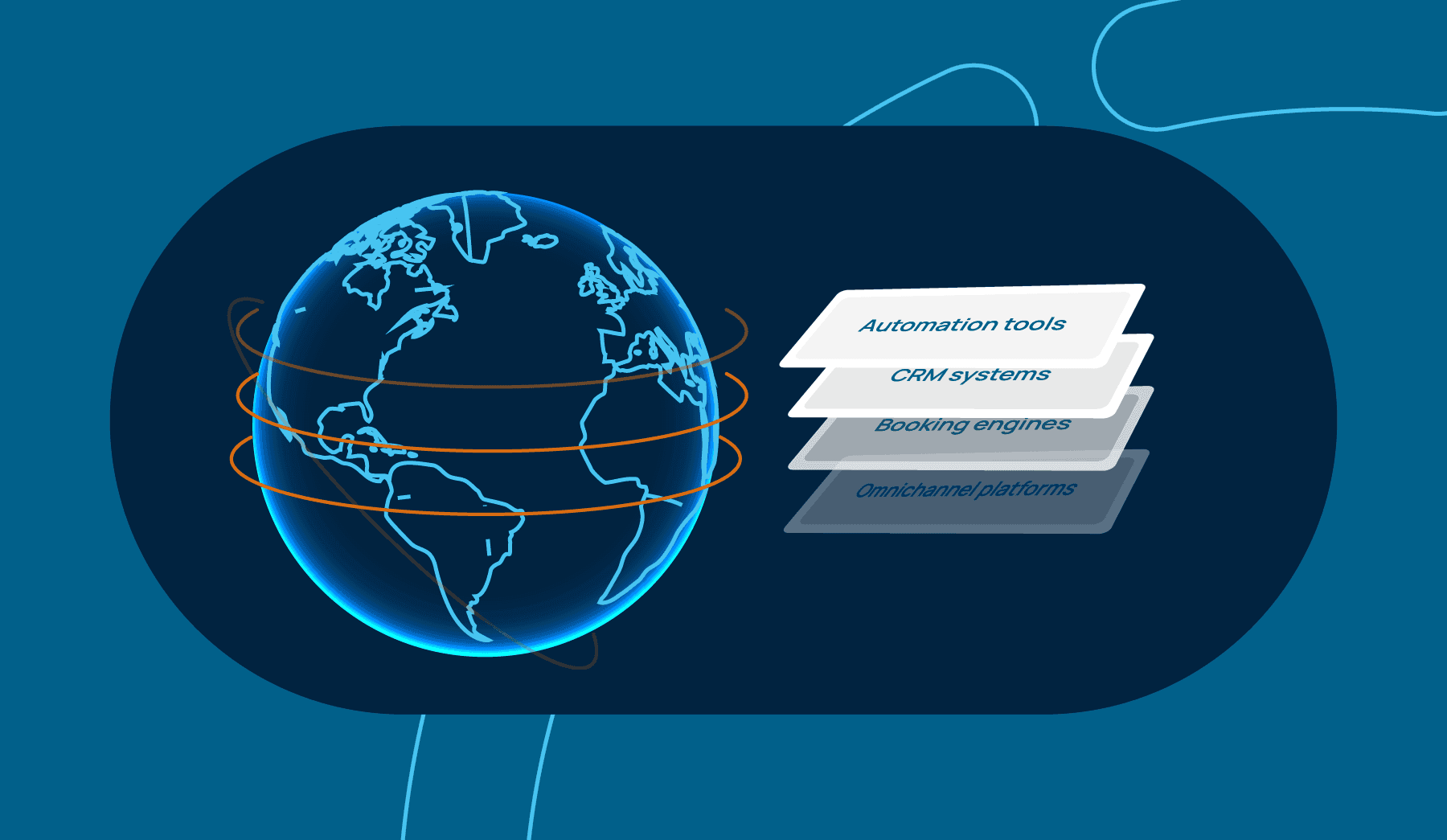Business Travel Market Trends in 2025: What TMCs Need to Know?

As someone who has spent over two decades inside the cockpit of travel tech, I have witnessed platforms emerge, standards promised, partnerships formed and broken, accounts depleted by feature bloat, and many brilliant founders crash their rockets when confronted with operational friction. If you run a travel management company (TMC) today, you face a brutal mix of opportunity and operational debt. The market is not only large, but it is also in constant motion. Global corporate travel spend reached $1.48T in 2024 and is projected to hit $1.64T in 2025, an implied 10.4 percent expansion.
Do you feel that pulse? Good. It is important to know the ins and outs of the market because unless you read the runway right, how would you ensure your TMC takes off? Read this insight for all the data-backed business travel market trends, and accordingly shape your TMC growth strategy.
1. Corporate Travel Market Levers
A CXO at any travel agency cares about the top line and margin mix. The good news for TMC CEOs is that corporate travel continues to disproportionately drive airline and hotel economics.
In the United States, corporate travellers account for roughly half of airline profits, and they drive about 70 percent of global high-end hotel revenues.
That means, as a TMC, you’re sitting on the axis of travellers, suppliers, and corporate policy, where small positive shifts in market behaviour can translate to big dollars.
Meetings and Events (MICE) are a significant growth lever for business travel. Per attendee cost has surged sharply in recent years; MICE spend per attendee day is up 92% in 2025 versus 2021. These trends drive boardroom-level capital flow decisions and shape how procurement, finance, and sales align with travel programs.
2. Traveller Experience is Your Product Too
Most travel managers still think travel is about fares and rooms. They are only half right. The business traveller's end-to-end experience is what makes a complete product package from TMCs. 76% percent of business travellers report that they enjoy travel, and 67% strongly feel that it is important for a career upside. But seldom does enjoyment collide with reality. Nearly nine in ten travellers reported running into delays, cancellations, or unplanned rerouting. When your traveller client lands at midnight, exhausted and offline, every policy, SL, and up-sell vanishes. How you stitch together disruption handling, real-time rebooking, and meaningful traveler assistance determines whether you are a commoditised booking engine or a trusted TMC partner.
3. Approvals, Controls, and the Paradox of Flexibility
Whilst travellers want flexibility, travel reports suggest contradictory signals: cutbacks across blended travel, overnight stays, and premium seating. Procurement and travel admins have tightened the screws. Two-thirds of companies report increased pre-travel approval requirements, and nearly a third require approvals for every trip. Your TMC need to account for these trends and offer a balanced solution that helps your direc clients (corporates) implement their policies, and meanwhile ensure that travel is not a pain for the actual business traveller.
4. Distribution and the Content Problem
If there is one technical headache every TMC sees, it is content. Airlines do not always expose their richest fares and ancillaries. Roughly one-third of travel managers say airlines are not sharing full content, which forces workarounds, patch APIs, and brittle ETL processes. TMCs with in-house booking solutions for corporates are mostly trying to put out the fire from technical glitches.
The industry promises retailing and New Distribution Capability (NDC), but conversion to stable feeds is messy. For teams building integrations, it means designing solutions for idempotency, retries, rate limits, and data reconciliation. Your integrations must tolerate partial content updates by airlines; they must reconcile PNR-level state across suppliers and your corporate policy engine. Of course, it becomes hectic at times, but to keep the business running, you've to do the dirty work. I suggest TMCs with limited technical muscle to procure and serve their clients with a managed SBT & Expense solution, as the overheads are minimal with this approach.
5. AI is a Mandate Wrapped in Scepticism
95% of travellers say they may use AI-led itinerary planning, and 91% are open to AI-enabled booking options. Yet only 7% are comfortable today. The technical work is not just model training; it is data ops and governance.
To offer AI to corporates that respect their organizational policy, you need a robust booking engine that can take inference outputs and map them to approvals, cost centres, and audit trails. You need an AI solution with traceability, explainability, and the ability to rollback model outcomes when a legal or privacy question arises. Choose a travel tech provider that has designed systems with MLOps pipelines, versions every feature flag, logs every recommendation, and instruments feedback loops so personalization improves responsibly.
6. Sustainability will Stop Being Optional
Sustainability is no longer a lip-service from leadership. Yes, that's a blunt allegation, but we know many did so. Anyway, rail efficiency and zero-emission mobility are highly sought after by travellers. Trains can reduce emissions by orders of magnitude relative to short-haul flights, and for some routes, they are 97% more carbon efficient. Employees are noticing. 23% cite carbon reduction features as critical in booking tools, and adoption of multimodal booking options is climbing. On fuels, sustainable aviation fuel (SAF) production is scaling quickly. The industry produced roughly 600 million litres of SAF in 2023, and production expectations are slated to rise aggressively. The consequence for TMCs is product and reporting. Clients will demand low-carbon itineraries and ESG-gradeable travel reports. That requires trip-level carbon attribution, vendor-level emissions data, and integrated booking flows that allow corporate clients to price in carbon as a decision vector.
7. Pricing, Packaging, and New Revenue Plays
Margins tighten when corporate clients ask for a lower cost class mix. Expect more pressure on premium inventory as travelling corporates optimize. You can offset margin compression by selling value rather than just a commodity.
- Offer disruptive insurance offers, dynamic traveller wellbeing modules, and data subscriptions that help procurement predict spend variance. The analytics you already run for corporate programs can be productised into forecasting tools.
- Create packages that bundle policy enforcement, real-time disruption handling, and ESG reporting.
If you rely on commission-only models, you will find it harder to monetise the extra engineering you now have to deliver.
8. People, Inclusion, and Generational Behaviour
Gen Z and millennials want different things. More than half of Gen Z expect to travel more in the coming year, and a significant share plan to extend business trips for leisure and even bring family. At the same time two two-thirds of employees say they have experienced unequal travel opportunities, citing age, seniority, or orientation. TMCs must design programs that are inclusive by default. That means accessibility options in booking flows, support for dietary and medical preferences, and policy constructs that allow equitable access without manual escalation. Also, training and change management must be baked into product releases because you cannot ship transformational technology without influencing a change in customers’ behaviour.
Ensure that your travelTech vendor ticks all of these boxes before you sign their contract.
9. Operational Friction and the Automation Imperative
Travel managers still wrestle with manual processes. 60% of travel and finance teams process expenses manually, and more than three-quarters want an all-in-one travel and expense platform. Manual expense processing is a structural inefficiency. If you are building or integrating an expense engine, prioritise bank-grade reconciliation, OCR with confidence thresholds, and automation that routes only exceptions, not everything, to humans. Your goal should be to reduce cognitive load for the travel admin while preserving audit fidelity for finance. That is how you increase retention for your TMC with business buyers.
10. Risk, Safety, and Candid Travellers
Safety is a deal breaker. 92% of travellers say they are willing to decline trips for safety or political reasons, with safety topping the list. Your duty of care is not a compliance tick. It is a product layer that includes country-level risk profiling, regional health advisories, and proactive trip mitigation flows. Integrate live country risk APIs, automated checklists for visas and docs, and two-way communications that scale. If travellers feel unsupported in a crisis, they will bypass your systems, and that quickly becomes procurement’s headache. You don't want that, as it may result in a high client churn rate.
What to Prioritise from a TMC POV
We must choose what to build, buy, and partner. Do not try to own every piece of travel tech.
- Partner with specialized suppliers that provide hard-to-replicate value, like live supplier content or country-level risk intelligence.
- Build core policy and reconciliation logic in-house.
- Commercially, price your self-booking tool as a platform plus services, not commission only (your SBT vendor must support flexible pricing models where you can add your margins or customise your offerings). That aligns incentives and keeps you buying engineering time to close real gaps.
From a technical POV, stop thinking in monoliths. If you're building in-house solutions for your corporates-
- Build API-first services that separate booking, policy, analytics, and traveller profile.
- Implement event-driven architectures for real-time state and idempotent handlers for supplier reconciliation.
- Invest in data lineage and a single source of truth for corporate policies.
- Deploy feature flags for experimentation and A/B test every pricing or UX change with measurable KPIs.
- Create a feature called policy simulator so procurement can test a policy change without disrupting live bookings.
- Version everything. When a client asks what changed in policy mapping two months ago, you should be able to answer with a commit hash and an audit log.
The Long Game for Your TMC
The industry is abuzz with terms like retailing, digital identity, AI-led travel, SAF, carbon accounting, and multimodal booking. Pick a travel tech stack that maps to your clients' pain points and iterate relentlessly. Be surgical.
Be humble about AI if you're building your own fine-tuned models, but do experiment aggressively, and loop back the learning into your AI model improvement. Or partner with AI-obsessed travel tech providers.
Invest in building relationships with travel admins because they are your levers for retention. And remember that travellers are people with careers, families, health, and preferences. Choose a travel & expense tool designed for that complexity, and you’d win more trust and contracts.
Remember, as a TMC, you’re not in the business of selling trips; instead, you deliver reliable, auditable, and humane corporate mobility that makes the enterprise more productive and resilient. In 2025, that means less flirtation with shiny tech and more discipline in execution.
Keep scaling your TMC!

Ranga Prasad Badasheshi
Co-founder at TripGainIn this article
1.Corporate Travel Market Levers
2.Traveller Experience is Your Product Too
3.Approvals, Controls, and the Paradox of Flexibility
4.Distribution and the Content Problem
5.AI is a Mandate Wrapped in Scepticism
6.Sustainability will Stop Being Optional
7.Pricing, Packaging, and New Revenue Plays
8.People, Inclusion, and Generational Behaviour
9.Operational Friction and the Automation Imperative
10.Risk, Safety, and Candid Travellers



